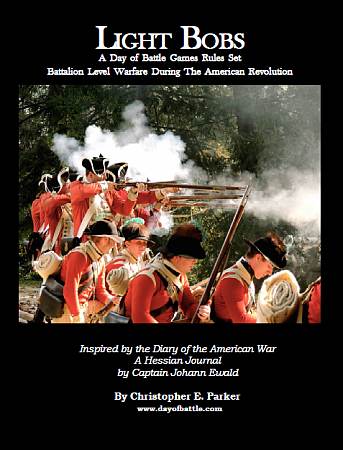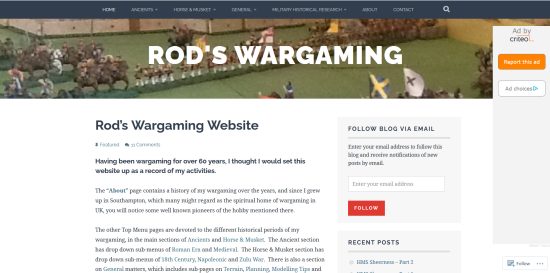
A Day of Battle Games Rules Set - Battalion Level Warfare During The American Revolution
Total Votes: 2
Description
From the publisher:
Light Bobs provide a wargame based on small companies led by individual officers during the American Revolution. The rules are named after the nickname given to the British Light Infantry in the period.
The rules are written to simulate battalion level combat where hundreds, rather than thousands, of soldiers are deployed. This is larger than an individual skirmish, but below a brigade or multiple battalion action.
The game is for two players using 25mm or 40mm figures. Each player commands 4 to 6 companies of 4 to 12 figures and is represented on the table by a special leader figure. This means games can be played with as few as 17 figures a side while an average game will involve some 33 figures a side. Action is fast and sharp with companies of mixed arms and varying morale types.
There are detailed army lists covering the four theaters of the American Revolution: Boston, Saratoga, the Mid-Atlantic States and the South. The lists, used in combination with the army creation rules, allow players to move from one theater to another, fighting actions with different types of armies. For example, an army in the Saratoga campaign looks entirely different from one in the South: the former has Indians but no mounted troops while the latter has mounted troops but no Indians.
To bring out the individuality of the scale and period further I have used the personality rules from one of my previous rule sets: Day of Battle. This allows players to learn, or not as the case may be, from battle to battle rising from the rank of Captain to the dizzying heights of General. This allows you to run a simple paperless campaign. I have also reused the command and battle line morale rules from Day of Battle so if you have used my rules before these sections will be more than familiar.
Before the game, each player determines the rank and stats of his Leader of Worth (LoW). A starting-level LoW is usually a Captain (Military Rank 3).
The Leader's rank determines the number of companies in his battalion. For example, a Captain would have four companies under him.
The army lists indicate what troops may be used. There is no point system. For example, the British Army - Saratoga Theater shows that the battalion much include at least two line infantry companies, and could have one company each of grenadiers, light infantry, Indians, or artillery. There could also be a second company of Rifle or Light, but not both.
Each company is also classified as elite, veteran, average or poor. This morale rating also determines the number of figures in a company, as higher morale units are more compact than lower morale companies.
The rules determine the placement of terrain, and the players can select from five scenarios.
At the start of each turn, players determine which has the first move. The player moving first then determines how many command points he receives for that turn (unused points can be saved from turn to turn), and begins giving orders to individual companies or the battalion line. Orders are given by spending command points, by issuing personal orders (once per turn to unit leader is attached to), or by using command staff (essentially 'expending' one of three staff figures). When he is finished, the second player may give orders to his forces.
Companies are either in line or column, and in close, loose or (Indians only) open order. Movement rate depends on troop type and formation. Charges occur as part of movement, and th opposing unit may counter-charge, retreat, or evade.
Companies accrue disorder markers (DIS) as they are given orders, after melee, and when other units break. Companies become 'spent' when they accumulate too much disorder (depending on morale rating). A leader may reduce disorder ('reorder') by using command points.
To resolve shooting, a number of combat dice are rolled based on number of figures in the company, modified by the company's morale. (For example, an elite company of 4 figures would roll 8 dice, because elites get 2 dice per figure.) Rolls of '1' are re-rolled for second chance of a hit. The defender then attempts saving rolls (modified by range, terrain, and troop type). Successful hits result in figure loss and a morale marker. In some cases, the defender is allowed 'return fire' (considered simultaneous).
Melee combat uses a similar procedure. The losing side retreats after melee is resolved.
Leaders must check their fate if involved in combat.
As battle ensues, the battalion accrues both permanent and temporary morale markers from threats to the flanks, from combat losses, and from loss of companies. When any company suffers an adverse result, the battalion must test its morale. If the battalion fails its morale test, the player selects which companies will retire, retreat or break.
After the game, leaders receive points to increase their skills, and may achieve promotion.
Four pages of optional Advanced Rules add complexity to the game system, including new rules for Indians, Woodsmen and Sharp Shooters.
Rulebook includes a description of a sample turn, and five scenarios:
- On Patrol
- Meeting engagement between equal forces.
- Hold At All Costs
- Defending a supply depot.
- Advanced Guard
- Defending a bridge or ford over an impassible stream.
- Bunker Hill, The Fence Line
- 4-player historical scenario of the first British push against the fence line at Bunker Hill.
- The Wheat Field
- Forces fight while trying to claim food or forage from the battlefield.
Editions
Current edition is the revised second printing.









